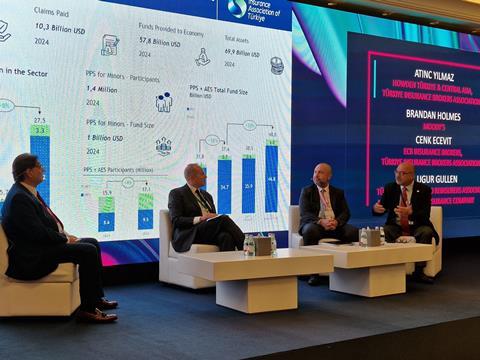Turkish industry leaders speaking at the DWIC event in Dubai said disinflation and regulatory clarity may unlock fresh capacity and foreign investment.
Turkey’s re/insurance market is targeting rapid growth over the next decade, with panellists at DWIC 2025 in Dubai voicing cautious optimism about economic reform, improved risk modelling and a more integrated re/insurance ecosystem.

Ugur Gullen, chairman of the Türkiye Insurers and Reinsurers Association and board member at Ak Sigorta, emphasised that Turkey’s market is the largest between the Middle East and Europe, with total gross written premiums of more than $25bn.
“We promised this market would grow,” said Gullen. “We are going to double that volume in the next five to ten years. Almost all members of the ecosystem have committed to that target.”
Gullen highlighted Turkey’s insurance penetration rising from 1.7% to 2.5% of GDP in the last decade, driven by growth in health and pension lines. Medical insurance policies now number nine million, with total pension fund assets reaching $35bn.
“We’ve started referring to it not just as the insurance industry, but as the insurance ecosystem,” he said. “Each stakeholder feeds the other, so the ecosystem grows together.”
Distribution power and market resilience
Atinc Yilmaz, regional CEO at Howden Türkiye and Central Asia, emphasised the role of distribution in enabling growth. “There are more than 20,000 agents and over 9,000 licensed brokers,” he said. “That’s an ecosystem of more than 20,000 people actively dealing with insurance.”
Cenk Ecevit, owner of ECB Insurance Brokers and chairman of the Türkiye Insurance Brokers Association, stressed brokers’ growing influence. “In non-life, brokers’ market share is up significantly, and I believe it will increase further as advisory services grow in importance.”
Following the tragic 2023 earthquake that struck the country and neighbouring Syria in February that year, panellists said market conditions had stabilised. “We saw a sharp price correction due to capacity shortages post-quake,” said Gullen. “But now supply and demand are more balanced. We’re not in a soft market, but it’s no longer hard either.”
Ecevit added that the market’s approach to risk assessment had matured. “Ten years ago, insurers lacked good risk assessment,” he said. “Now almost all companies conduct site inspections. Good risks are getting cover—bad ones are being filtered out.”
Macroeconomic reform and investor interest
Brandan Holmes, vice president and senior credit officer at Moody’s, said inflation had peaked above 75% but was now falling thanks to more orthodox monetary policy.
“The central bank’s actions have pushed inflation into a declining trajectory,” he said. “We now expect mid-20s inflation by 2026. That’s helped cut the current account deficit and stabilise the lira.”
Holmes said these reforms prompted Moody’s to upgrade Turkey’s sovereign rating. “We moved it from B3 to B1, with a stable outlook,” he said. “The key question is whether the macroeconomic stabilisation is sustainable.”
Despite political volatility, he said decisive moves by the Turkish central bank suggested continued support for reform. “That’s encouraging,” he said. “Turkey is a large, dynamic economy with potential for growth—if challenges are addressed.”
Gullen added that the re/insurance sector could again attract foreign capital.
“Foreign ownership peaked at 75% of the market between 2001 and 2010,” he said. “That’s now down to around 60%. But if macro stability is achieved and growth continues, Turkey will be attractive to foreign investors again.”
Modelling, regulation and emerging risk
The 2023 earthquake exposed limitations in catastrophe models, said Holmes. “Fault lines ruptured in ways the models didn’t anticipate. Local soil conditions and building code compliance also affected outcomes.”
He said newer, high-definition models with better input data are being adopted. “Every meaningful event improves the models. But it’s vital to remember models are just one input—not the whole answer.”
Gullen said regulators had also raised capital requirements, with $100 million minimum capital now needed to launch a non-life insurer. “They’ve widened their scope to supervise the whole ecosystem, from insurers to repair shops,” he said. “Certification and oversight are being expanded to all stakeholders.”
Looking ahead, panellists pointed to cyber, usage-based policies and parametric products as key growth areas for Turkish insurance buyers. “Complementary health cover is also growing fast,” said Ecevit. “People want affordable options.”
Gullen closed the discussion with a note on resilience. “We’ve improved our skills to handle uncertainty; weekly scenario planning is now part of our DNA.”










No comments yet